McClain’s:
What led you to become an artist?
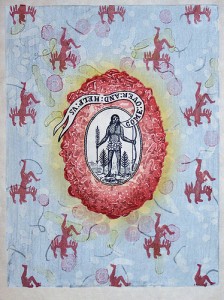
10 Little 9 Little Indians
Annie:
I came to the visual arts in a roundabout way. I majored in English literature in college thinking I’d like to be a writer, but after a few years working odd jobs it became clear that I needed a more marketable skill. On the advice of a friend I did a quick 12-month program in Technical Drawing and landed a job at a textbook illustration company, then a position as an illustrator/art director at a weekly computer magazine in Boston. This was in the 1980s when the Mac was just starting to infiltrate publishing, so I had the good fortune of learning the new field of computer graphics on the job. I went out on my own as a freelance illustrator in 1992, having developed a specialty in information graphics (maps and diagrams).
McClain’s:
How were you first exposed to printmaking?
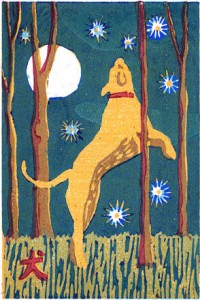
Year of the Dog
Annie:
About 6 or 7 years ago I began to yearn for a change. I wanted to tell my own stories rather than the stories of my clients; wanted to get off the computer and make work with my hands; wanted to get away from the pressure of constant deadlines. I began to make pencil or ink drawings that I then scanned, adding color and texture in Photoshop. People kept telling me that this new work looked like Japanese woodblock prints, so in the spring of 2005 when I heard that a three-day workshop in Japanese woodblock (moku hanga) was being offered in my area, it seemed obvious that I should give it a try.
The workshop, taught by New Hampshire woodblock printer Matt Brown (http://www.ooloopress.com/), was a somewhat grueling experience cranking out a 5-block print in three days, but I loved it. Color separation, overprinting, and layering all seemed intuitive to me after so many years working with CMYK graphic files on the computer, and the idea of making multiples also fit in with my publishing experience. Best of all was the fact that the Japanese method is clean, green, compact and portable, no press or solvents required, so I could easily integrate it into my home studio and keep doing my digital freelance work while I was developing my woodblock skills.
I ordered a good set of Japanese carving tools, some wood and some paper and started making prints. During the workshop Matt had told us about Baren Forum (http://www.barenforum.org) and I discovered that with help from the members of the Forum plus the vast database of information on the Forum website I was able to essentially teach myself and get almost-instant solutions to any problems as they arose.
McClain’s:
What inspires your work?
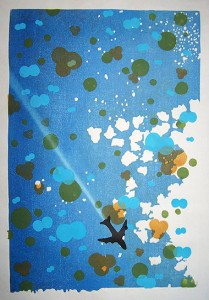
Melting
Annie:
I make prints about things that puzzle or concern me, things I don’t understand or that I want to know more about, things in the newspaper that upset me, stories that intrigue me, concepts that feel elusive. Most of my prints begin as words or a title or a question. I suppose that’s no surprise considering that my job for the past 20+ years has been to create images to accompany texts.
Once I know the topic I want to explore I immerse myself in it as fully as possible by doing visual research, reading on the topic, talking to people about it, sketching, playing with word-imagery, and even by playing music from that era or place or mood while I work. Making a multi-color woodblock print takes a great deal of time, so I consider the entire process, including what I listen to and how I conduct myself in the studio, to be part of the print.
Although my prints are motivated by questions, I’m not so much seeking to answer the questions definitively as I am to simply make a record of the possibilities I explore and discover. Multi-block printmaking is great for this because of the possibilities inherent in layering. Images, time periods, visual styles can all be juxtaposed in new ways. I enjoy “packing” information into a print that can later be “unpacked” in various ways to reveal new connections and surprises.
McClain’s:
Could you explain your process:
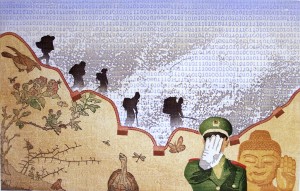
Great Wall
Annie:
Once I have my sketch ready, I decide what size I want the print to be and I scan and scale it accordingly. I use a number of different methods to transfer the image(s) to shina plywood blocks — tracing an image onto the block with tracing paper and/or carbon paper; pasting a laser print to the block and carving through the paper; drawing directly onto the block. Most of my carving is done with a straight blade (hangi-toh) followed by gouges for clearing. I use the traditional Japanese method for printing — waterbased pigments plus a little rice paste mixed on the block with a horsehair brush and then an impression taken with a baren. I use three different baren: the traditional Murasaki baren, a ball-bearing baren, and a plastic disk baren. I like each one for different applications, although the Murasaki baren is the most versatile.

Locusts in Babylon
I edition my prints, but my editions tend to be small, usually 10 to 20 prints. I get bored doing more than that. I also don’t do much pre-proofing. I like the excitement of just doing it as I go along. I usually cut 4 or 5 extra sheets of paper and use those at the front of every run to test the colors, baren strength, etc. before I do the full run. In the beginning I used to plan out all the colors and layers, carve all the blocks in succession, and then do all the printing at once but these days I’m more likely to carve a block or two, print a few passes, evaluate what I’ve got and then carve another block or two and print some more. This lets me respond to the various surprises and ideas that crop up as the print progresses. Sometimes I scan a partially finished print and experiment with colors or image elements in Photoshop before I carve and print the next block.
The other thing that has become an integral part of my process is blogging. (http://woodblockdreams.blogspot.com) I started my blog at the urging of a friend in Virginia who wanted to “watch” me learn the technique, but it has become a true journal, a place where I record and document my process for every print. I also get wonderful feedback and information from other printmakers from all over the world and I’ve made many virtual friends through blogging. After 5 years, the blog is kind of huge and unruly and at some point I’ll probably stop doing it, but I’m not ready to quit just yet.
McClain’s:
Any carving/printing secrets you’d like to reveal or advice you’d like to pass along?
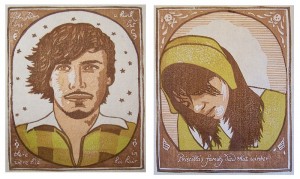
John Alden and Priscilla Mullins
Annie:
The advice I’d like to pass along to anyone who wants to tackle the Japanese method of woodblock printing is to start simple and be a scientist. The Japanese method can be pretty finicky because there are so many variables — type of paper, type of wood, style of carving, baren pressure, amount of pigment, amount of paste, etc. Everybody will tell you the “right” way to do it, and more often than not you’ll hear three or four different “right” ways to do it, so you have to be your own scientist. Being a scientist means being really observant, trying to isolate and change one variable at a time so you can really see the effect. This is easier to accomplish if you start with a simple design until you get the feel for all these variables.
McClain’s:
Do you keep a sketch book? How important do you think it is for an artist to have one?
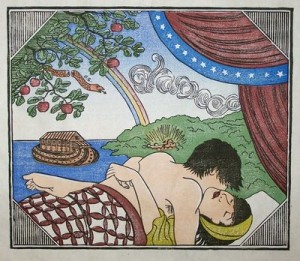
American Bible Story
Annie:
I hear it’s very important for an artist to keep a sketchbook, but I’m not really that kind of an artist. I don’t do life sketches, so the book I keep is more like a notebook or a journal. There are more words than pictures in my book, but my word-sketches and chicken-scratch drawings and ideas are important to me and I refer back to them often, so I like to have them all in one place.
McClain’s:
Do you have a favorite print you’ve done and if so why?

Three Prophets
Annie:
The prints that are most meaningful to me are the triptych called “Three Prophets.” The series took about 8 months and was part of my post-9/11 contemplation on religion. I wanted to focus on the three major evangelistic religions (religions that intend to convert others) that were built around single charismatic individuals: Buddhism/Buddha, Christianity/Jesus, and Islam/Mohammed. Each print is basically a map, based on a satellite view of the location where each of the three prophets/teachers was born. The thing I love the most about these prints is that in focusing on the birthplaces of these three men it’s actually their mothers that I ended up invoking. All three of these so-called divine beings were born of the earth and born of women, women who were their first teachers and who presumably taught their sons what it is to be human, as all mothers do. I wonder how much of their mothers these men carried within themselves as they grew to fulfill their destinies.
I have these prints mounted like scrolls hanging in my living room and I still love looking at them. (http://woodblockdreams.blogspot.com/2008/06/three-prophets-in-my-living-room.html)
McClain’s:
Where can we find your work?
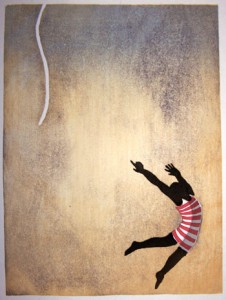
Let Go
Annie:
I’m represented by Cullom Gallery in Seattle (http://www.cullomgallery.com), a gallery that focuses on the tradition and influence of Japanese woodblock prints. Beth Cullom found me online a couple of years ago when her gallery was new and so was my printmaking. I’m enjoying growing with her. I’d like to find a gallery here on the east coast too, but it hasn’t happened yet.
As for online venues, I tried working with an etsy.com store, but it didn’t work out very well for me. I do sell online when someone contacts me through my web site (https://www.anniebissett.com/).
McClain’s:
Do you make prints for love or profit?
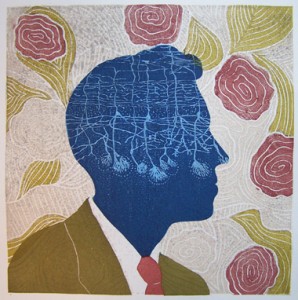
Smell the Roses
Annie:
I still consider myself new to printmaking. I’d love to get to the point where I earn my living solely from my fine art prints, but I’m not there yet and it’s possible that I may never reach that goal. A lot of my work veers toward the political, which I suppose narrows my potential audience quite a bit, but I’m unwilling to make prints just because I think they’ll sell. I wouldn’t enjoy that.
So the answer is, I make prints for love. I make prints because I have something I want to express and I hope that eventually the work will make its way to its proper audience. For now I’m just focusing on making the prints, taking advantage of opportunities that arise, applying for shows or grants that seem right for me, and riding the waves as they come. I’ve had some nice recognition this past year, having prints selected for juried shows by Boston Printmakers, Los Angeles Printmaking Society and International Print Center of New York. I still have a lot to learn about how the fine art world works, but I do know that making the prints is my first order of business.
